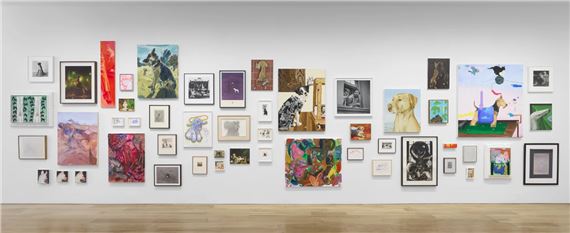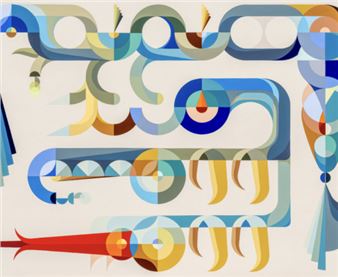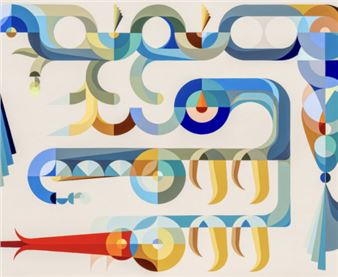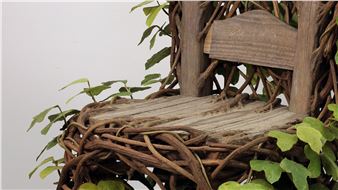Dog Days of Summer
Timothy Taylor is pleased to announce Dog Days of Summer, a group exhibition that centres on man's best friend as a timeless subject in art history. Opening on 20 June in New York, the exhibition includes more than sixty works exploring the many roles a pup might play in the life of an artist: muse, metaphor, and companion.
Artmaking is a famously solitary process. What would art of the last century have been without such faithful studio mates as William Wegman's Weimaraners or Pablo Picasso's (ungenerously named) dachshund Lump? Dogs have been a feature of visual culture since at least 8,000 years ago, when hunter-gatherers carved an image of leashed dogs into a sandstone cliff. A symbol of fidelity, protection, playfulness, and unconditional love, canines pop up in the paintings of Titian, Jan van Eyck, John Singer Sargent, and Gustave Courbet, among countless other masters.
Dog Days of Summer will feature Yellow Lab (2022), a stately seaside portrait in meticulous detail by Sean Landers, alongside works created specifically for the exhibition by Hilary Pecis, Jesse Mockrin, and Ann Craven. In Pecis's Mango (2024), a smart, diminutive pup nestles into an array of pillows whose vibrant patterns seem to distort the perspective of an otherwise familiar domestic scene. Another lapdog appears in Mockrin's graphite drawing Pearl (2024); here, the dramatic curl of a pug's tail mirrors the Rococo embellishments of its owner's gown. Elsewhere, Craven's lush, painterly Magic and Moonlight in Night Field (2024), evokes the sinewy physicality and anthropomorphic nature of a French Bulldog.
Across these works, artists explore the specific body language and intimacies that humans share with their canine companions. Wegman's photograph Look (1989) pictures four of the artist's famous pets sitting uniformly in chairs, perfectly rapt, their piercing amber eyes presumably meeting those of the artist. In Jonas Wood's etching Three Dogs (2020), the titular crew appears with tongues wagging, each gazing lovingly at the viewer, while Louis Fratino's work on paper Man and Dog (2018) suggests the similar ways in which humans and dogs find comfort and connection.
Other works reflect the role of dogs in history and fantasy, consumerism and psychology. Karen Kilimnik's seductive and shadowy painting friends in the woods (2010) references Old Master canine scenes, picturing a nocturnal gathering of dogs of various stock beside a steaming cauldron. Robert Gober's 1976 photograph Untitled also features an assembly of breeds, zeroing in on three distinguished "eager eaters" in dog food branding. Peter Saul, with characteristic irony, plays on our expectations of our furry friends in the work on paper Watchdog (2011), depicting a dopey, deranged creature with a halo. And with the sculpture Lucy (2021), a Pop-inspired puzzle of a pup holding a flower, Alex Da Corte suggests dogs are more than they seem.
With paintings, sculptures, drawings, prints, and photographs dating from 1915 to the present day and running the stylistic gamut, Dog Days of Summer offers up a collective portrait of our mutual evolution with our canine companions, in life and in art.

Recommended for you
Timothy Taylor is pleased to announce Dog Days of Summer, a group exhibition that centres on man's best friend as a timeless subject in art history. Opening on 20 June in New York, the exhibition includes more than sixty works exploring the many roles a pup might play in the life of an artist: muse, metaphor, and companion.
Artmaking is a famously solitary process. What would art of the last century have been without such faithful studio mates as William Wegman's Weimaraners or Pablo Picasso's (ungenerously named) dachshund Lump? Dogs have been a feature of visual culture since at least 8,000 years ago, when hunter-gatherers carved an image of leashed dogs into a sandstone cliff. A symbol of fidelity, protection, playfulness, and unconditional love, canines pop up in the paintings of Titian, Jan van Eyck, John Singer Sargent, and Gustave Courbet, among countless other masters.
Dog Days of Summer will feature Yellow Lab (2022), a stately seaside portrait in meticulous detail by Sean Landers, alongside works created specifically for the exhibition by Hilary Pecis, Jesse Mockrin, and Ann Craven. In Pecis's Mango (2024), a smart, diminutive pup nestles into an array of pillows whose vibrant patterns seem to distort the perspective of an otherwise familiar domestic scene. Another lapdog appears in Mockrin's graphite drawing Pearl (2024); here, the dramatic curl of a pug's tail mirrors the Rococo embellishments of its owner's gown. Elsewhere, Craven's lush, painterly Magic and Moonlight in Night Field (2024), evokes the sinewy physicality and anthropomorphic nature of a French Bulldog.
Across these works, artists explore the specific body language and intimacies that humans share with their canine companions. Wegman's photograph Look (1989) pictures four of the artist's famous pets sitting uniformly in chairs, perfectly rapt, their piercing amber eyes presumably meeting those of the artist. In Jonas Wood's etching Three Dogs (2020), the titular crew appears with tongues wagging, each gazing lovingly at the viewer, while Louis Fratino's work on paper Man and Dog (2018) suggests the similar ways in which humans and dogs find comfort and connection.
Other works reflect the role of dogs in history and fantasy, consumerism and psychology. Karen Kilimnik's seductive and shadowy painting friends in the woods (2010) references Old Master canine scenes, picturing a nocturnal gathering of dogs of various stock beside a steaming cauldron. Robert Gober's 1976 photograph Untitled also features an assembly of breeds, zeroing in on three distinguished "eager eaters" in dog food branding. Peter Saul, with characteristic irony, plays on our expectations of our furry friends in the work on paper Watchdog (2011), depicting a dopey, deranged creature with a halo. And with the sculpture Lucy (2021), a Pop-inspired puzzle of a pup holding a flower, Alex Da Corte suggests dogs are more than they seem.
With paintings, sculptures, drawings, prints, and photographs dating from 1915 to the present day and running the stylistic gamut, Dog Days of Summer offers up a collective portrait of our mutual evolution with our canine companions, in life and in art.
Artists on show
- Alex Da Corte
- Alex Katz
- Alison Elizabeth Taylor
- Allison Schulnik
- Ann Craven
- Anthony Cudahy
- Armen Eloyan
- Billy Sullivan
- Camilla Engström
- Camille Henrot
- Craig Kucia
- Craigie Aitchison
- Dana Schutz
- David Surman
- Eddie Martinez
- Gaby Collins-Fernandez
- Gordon Parks
- Grandma Moses
- Hanna Brody
- Hilary Pecis
- Jesse Mockrin
- Jonas Wood
- Julia Felsenthal
- Justin Liam O'Brien
- Karen Kilimnik
- Kiki Smith
- Louis Fratino
- Matthew Morrocco
- Pablo Picasso
- Paula Rego
- Paul-Sebastian Japaz
- Peter Hujar
- Peter Saul
- Robert Gober
- Robert Mapplethorpe
- Robert Roest
- Rocio Navarro
- Sahara Longe
- Scott Csoke
- Sean Landers
- Sophie Barber
- Sophie Larrimore
- Susumu Kamijo
- Timothy Hull
- Trisha Baga
- Will Ryman
- William Wegman
Related articles
Dog Days of Summer, a group exhibition devoted to our darling companions, explores humor, adoration, fidelity, and companionship.
A sprawling group exhibition at Timothy Taylor is an ode to this sluggish time and the furry companion with which it shares a name.
Make sure not to miss shows featuring Jenny Holzer, LaToya Ruby Frazier, Huong Dodinh, and others, plus a lot of dogs.

 ARTISTS
ARTISTS
















